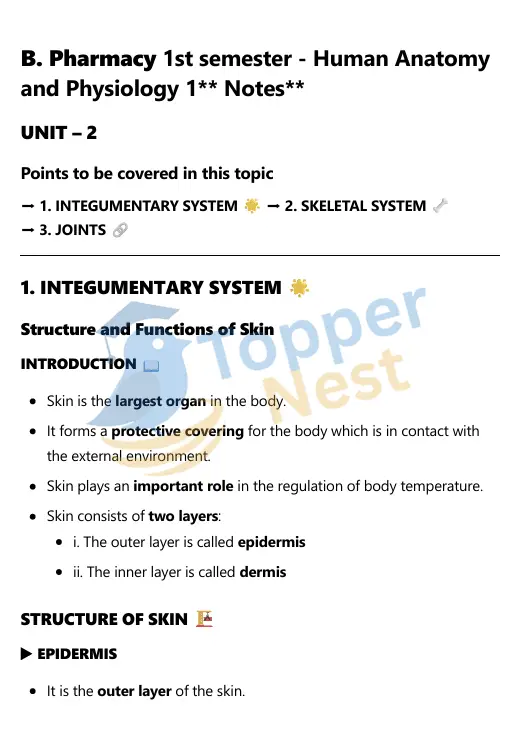Understanding the structural framework and protective systems of the human body is crucial for pharmacy students. Unit 2 of Human Anatomy and Physiology 1 covers three key systems: the integumentary system, skeletal system, and joints. These systems provide protection, support, movement, and play a major role in drug absorption, muscular coordination, and clinical diagnosis.

Introduction Integumentary System
The integumentary system is the body’s first line of defense. It includes the skin, along with associated structures such as hair, nails, and sweat glands. It not only protects the internal organs but also helps in thermoregulation, sensation, and drug absorption—making it especially important in transdermal drug delivery.
Structure and Functions of Skin
The skin is composed of three main layers:
- Epidermis: The outer layer that provides a waterproof barrier and creates our skin tone.
- Dermis: The middle layer that contains connective tissue, hair follicles, sweat glands, and nerve endings.
- Hypodermis: A deeper layer made of fat and connective tissue that helps insulate the body and absorb shock.
Key functions of the skin include protection from environmental hazards, regulation of body temperature, sensory reception, synthesis of vitamin D, and excretion through sweat.
What is Skeletal System?
The skeletal system serves as the internal framework of the human body. It supports soft tissues, protects vital organs, facilitates movement through muscle attachment, and plays a role in mineral storage and blood cell production. For pharmacy students, it is also relevant when learning about bone-targeted therapies like calcium supplements, bisphosphonates, or drugs used in arthritis and osteoporosis.
Divisions of the Skeletal System
- Axial Skeleton: Composed of the skull, vertebral column, and rib cage. It provides support and protection for the brain, spinal cord, and thoracic organs.
- Appendicular Skeleton: Includes the bones of the upper and lower limbs, as well as the shoulder and pelvic girdles, enabling movement and locomotion.
Types of Bones
- Long bones (e.g., femur)
- Short bones (e.g., carpals)
- Flat bones (e.g., sternum)
- Irregular bones (e.g., vertebrae)
- Sesamoid bones (e.g., patella)
Functions and Features of Bones
Bones protect organs, store minerals like calcium, produce blood cells in bone marrow, and serve as levers for muscle action.
Skeletal Muscles and Muscle Contraction
Muscles work closely with bones to create movement. Skeletal muscles are voluntary muscles attached to bones via tendons and are controlled by the nervous system.
Organization of Skeletal Muscle
Muscles are organized into fibers grouped in bundles, covered by connective tissue layers (endomysium, perimysium, epimysium). They work by contracting and relaxing in response to nerve impulses.
Physiology of Muscle Contraction
Muscle contraction occurs through the sliding filament mechanism involving actin and myosin filaments. This process requires ATP and calcium and is initiated by signals at the neuromuscular junction, where motor neurons stimulate muscle fibers using the neurotransmitter acetylcholine.
Definition of Joints in B. Pharmacy
Joints are the connection points between bones. They allow for flexibility and movement, and also help distribute force and maintain balance. For pharmacists, understanding joints is vital when studying conditions like arthritis, inflammation, and drug delivery to joint spaces.
Structural Classification
- Fibrous joints – Immovable (e.g., skull sutures)
- Cartilaginous joints – Slightly movable (e.g., intervertebral discs)
- Synovial joints – Freely movable joints with a synovial cavity (e.g., knee, shoulder)
Functional Classification
- Synarthrosis – immovable joints
- Amphiarthrosis – slightly movable joints
- Diarthrosis – freely movable joints
Types of Joint Movements
Includes flexion, extension, rotation, abduction, adduction, pronation, and supination—each contributing to different types of motion and stability.
Joint Articulations
Articulations refer to how bones connect at joints, held together by ligaments, cartilage, and joint capsules, depending on the joint type.
Frequently Asked Questions (FAQs)
1. How is the integumentary system important in pharmacy?
The skin is a common route for topical and transdermal drug delivery, and it also plays a role in protecting against harmful chemicals and microbes.
2. What’s the difference between axial and appendicular skeleton?
The axial skeleton protects vital organs, while the appendicular skeleton supports movement by forming the limbs and girdles.
3. What is the neuromuscular junction?
It is a connection point between a motor neuron and a skeletal muscle fiber, where nerve signals trigger muscle contraction.
4. What are synovial joints?
These are freely movable joints filled with synovial fluid, which reduces friction and enables smooth motion (e.g., shoulder, knee).
5. Why is understanding joints important in pharmacy?
Joints are commonly affected by inflammatory conditions like arthritis. Understanding their structure helps in drug development and effective treatment strategies.
